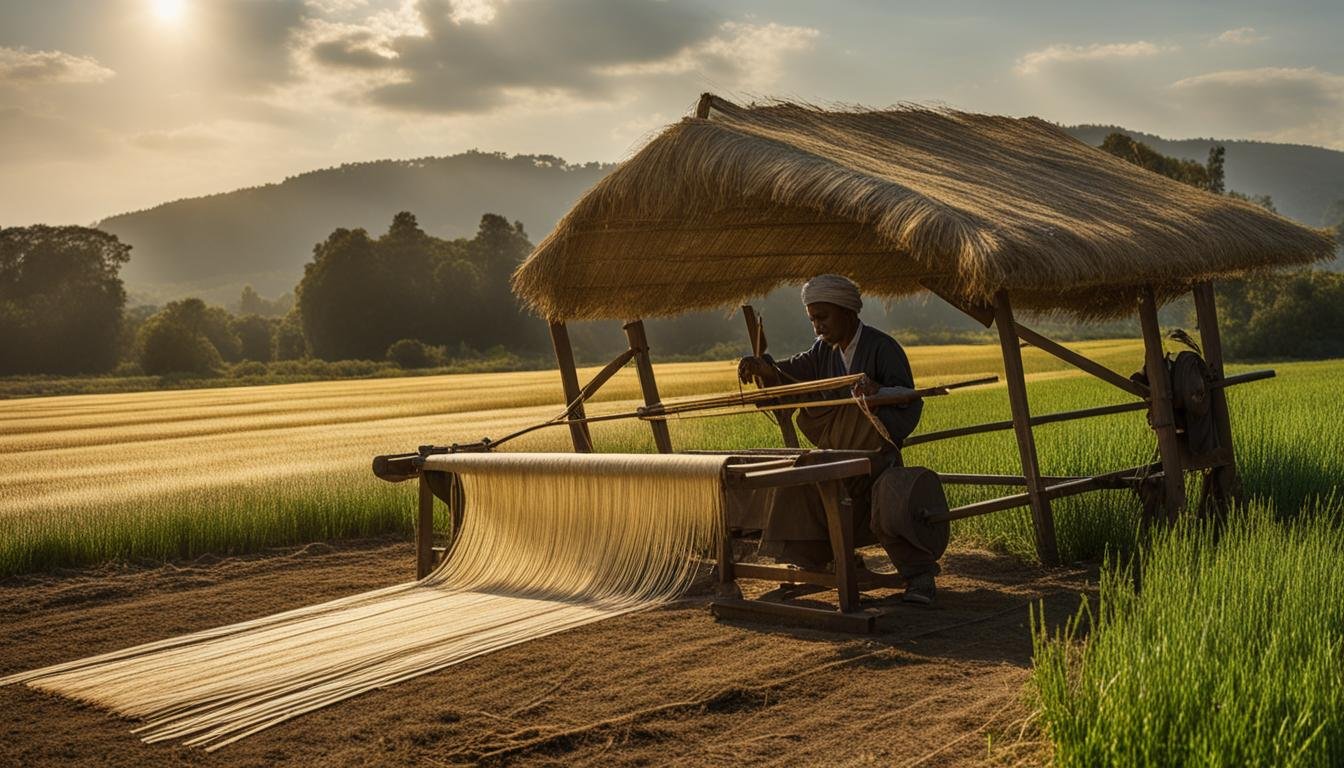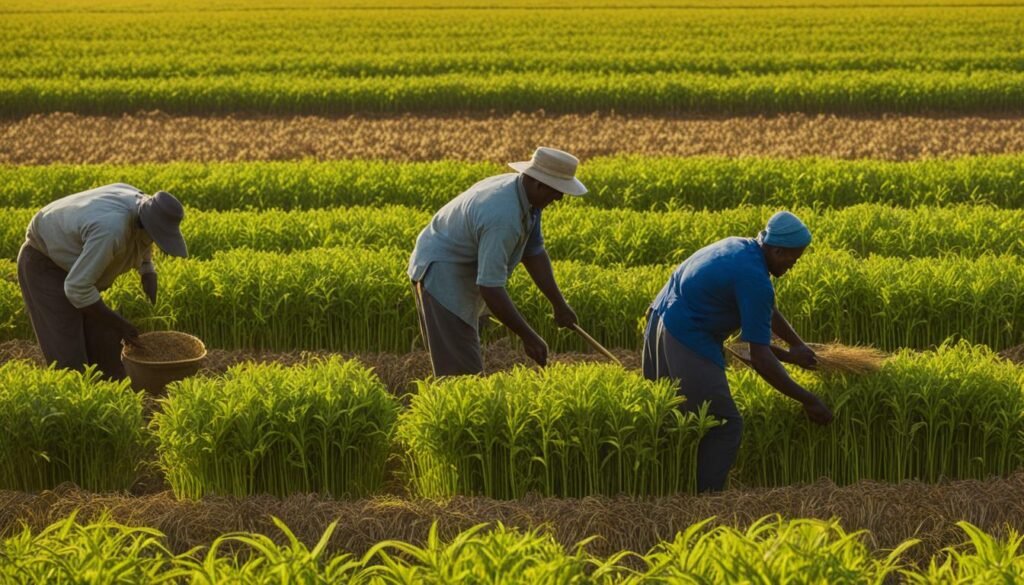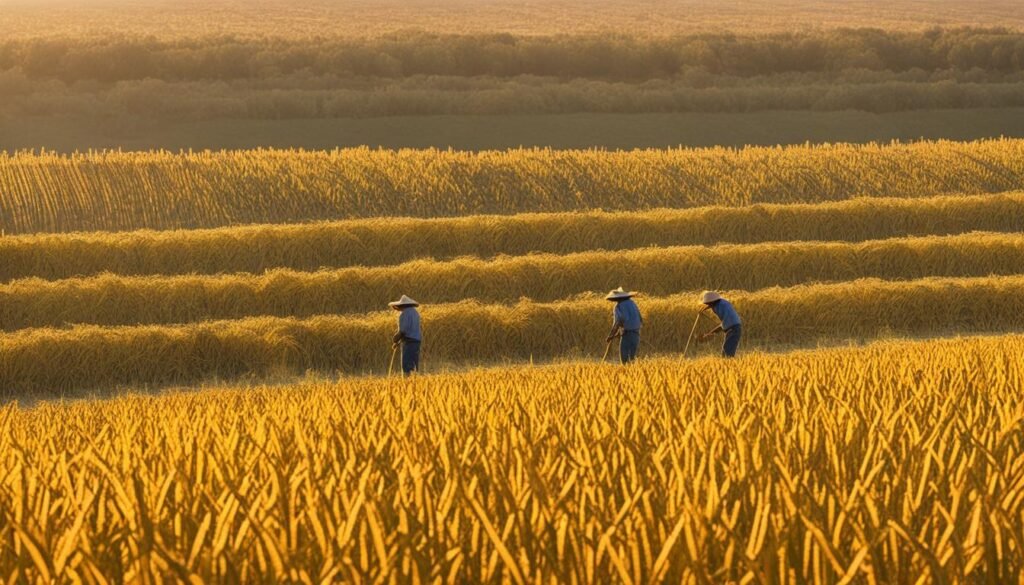Your cart is currently empty!

Unveiling the Process: How Linen is Made
The creation of linen fabric stands as a testament to the elegance and resilience of natural textiles. From the gentle sway of flax in the breeze to the crisp, cool touch of linen sheets, this fabric embodies a heritage-rich tradition and a commitment to sustainability. Engage in a journey through time and uncover the intricate, traditional linen making process—a craft that transforms the humble flax plant into a textile cherished across generations for its natural allure.
Every thread tells a story, one of human ingenuity interwoven with nature’s bounty. Follow the path of artisanal hands that have carried forward the techniques that underpin the creation of linen. Discover the stages from seed to loom that ensure the integrity and unique qualities of linen remain intact. You’re invited to explore how the ancient intertwines with the modern in the linen making process, forming a fabric that transcends the confines of time and place with its timeless grace.
Key Takeaways
- Understanding the step-by-step transformation of flax to exquisite linen fabric.
- Appreciation for the sustainable and eco-friendly nature of natural textiles.
- Insight into the commitment and craftsmanship of traditional linen making.
- Recognition of the comprehensive linen making process that balances tradition with innovation.
- Connection with a fabric that enshrines both historical significance and contemporary allure.
A Legacy of Lineage: The History and Origins of Linen
Spanning through millennia, ancient linen fabric has encapsulated the essence of civilization’s evolution. It’s a testament to humanity’s quest for craftsmanship, comfort, and cultural expression. Let’s delve deep into the storied past of this venerable textile.
The Ancestral Roots of Linen in Ancient Civilizations
The archaeological remnants of ancient societies unveil the threads that weave the narrative of linen’s origin. Flourishing amidst the fertile crescents of Egypt and Mesopotamia, linen held unparalleled esteem. This venerable textile was not merely a material for garments but a reflection of societal standing and the flow of commerce—embodying the historical significance of linen within these early cultures.
Linen’s Historical Journey from Currency to Clothing
Owing to its durability and elegance, linen transitioned from a bartering commodity to a symbol of sartorial finesse. Its sheen adorned the powerful and its resilience served the laborer, placing linen at the heart of economic and social life. The transition from currency to clothing is emblematic of linen’s inherent versatility and enduring appeal.
Cultural Significance of Linen Through the Ages
With a legacy interlaced in the very fabric of human history, linen’s cultural impact surged beyond the utilitarian, becoming synonymous with purity and ritualistic significance, especially within the pantheons of Egyptian deities. The prowess of linen stretched across time and geography, punctuating its irreplaceable role throughout historical tapestries and modern fashion trends alike.
| Historical Period | Role of Linen | Cultural Significance |
|---|---|---|
| Ancient Egypt | Garments, Wrappings for Mummies | Symbolized purity and status, used in sacred rituals |
| Middle Ages | Domestic Use, Clothing | Mark of social stature, widespread use in daily life |
| Industrial Revolution | Mass Production of Textiles | Transformation in manufacturing and availability |
| Modern Times | Fashion and Eco-friendly Textile | Resurgence as a sustainable, luxurious material |
In every thread and weave, linen carries the stories of epochs past—its lasting cultural impact a backdrop against which our collective narrative unfolds. From the banks of the Nile to modern ateliers of fashion, linen continues to drape us in history, comfort, and refined style.
Linen Defined: Properties and Characteristics
The natural composition of linen begins with its source: the revered flax plant. Each fiber is a testament to sustainability, with a minimal environmental footprint left in its wake. Among textiles, linen’s credentials for sustainability are impressive, owed in large measure to the innate properties of the flax plant. Fields of flax require considerably less irrigation than cotton, and significantly fewer pesticides are necessary to secure a flourishing crop. It is in this austere consumption of resources that linen defines its ecological ethos.

The cherished unique texture of linen is another cardinal feature that marks its distinction. This texture, often described as crisp and earthy, enhances with maturity; every wash tenderly softens its hand, while its original charm and strength endure undiminished. The tactile experience of linen is unparalleled – it is simultaneously rugged and refined, its weave speaking a silent language of historic use and artisanal quality.
- Breathability and moisture-wicking: Linen’s open weave allows air to flow freely, making it an ideal fabric for cool clothing.
- Durability: The strong natural fibers in linen contribute to a longer lifespan for linen garments and textiles.
- Hypoallergenic: Safe for those with allergies, its hypoallergenic nature makes linen a staple for bedding and clothing.
- Biodegradability: A hallmark of environmental consciousness, linen fabric decomposes safely back into the earth.
When we drape ourselves in linen, we wrap ourselves in the legacy of ancient civilizations and the promise of a responsible future. The sustainability of linen is not simply an attribute but a commitment to a world where elegance and care for the planet are interwoven – as enduring and intricate as the linen fibers themselves.
From Seed to Sheen: The Cultivation and Harvesting of Flax
The time-honored tradition of linen production begins with the meticulous cultivation of flax, an ancient crop esteemed for its sumptuous fibers. Distinct environmental conditions set the stage for the perfect flax growth, laying a natural foundation for high-quality linen.

Optimizing Climate and Soil for Perfect Flax Growth
Flax requires a specific climate and soil composition to flourish—a delicate harmony of nature that, when achieved, results in the most luxurious of fibers. Given the sensitivity of flax to its environment, rigorous attention is strong>paid to every detail.
| Climate Requirement | Soil Necessity | Outcome on Fiber Quality |
|---|---|---|
| Moderately Cool | Well-drained, rich soils | Exceptional luster and strength |
| Consistent cloud cover | Neutral pH | Increased fiber softness |
| Adequate moisture and rainfall | Minimal use of chemical fertilizers | Environmental sustainability |
Understanding the Lifecycle of the Flax Plant
The life journey of a flax plant is a spectacle of growth and renewal, culminating in the harvesting of flax plants when they display a golden-yellow hue—the harbinger of optimal fiber maturity. The lifecycle is a symphony of nature, nurtured by the hands of dedicated farmers.
- Seed Sowing: Precisely timed to the rhythms of nature.
- Growth: Rooted in tradition, shoots forge towards the sky.
- Maturation: Fibers develop resilience and elegance.
- Harvest: Gathered with care, the plants are poised for transformation.
By embracing the natural course of the flax plant’s growth, the artistry of linen creation is celebrated, from the earth unto the weaver’s loom. Each phase is imbued with a promise—of beauty, of quality, and of sustainability, safeguarding a legacy that textures our lives.
The Art of Retting: Preparing Flax Fibers
The technique of flax fiber retting is as much an art as it is a science, turning robust flax stems into delicate fibers ready for the creation of linen. This intricate process is indispensable to ensuring the flax fiber separation is successful, laying down a strong foundation for high-quality linen. Historically, traditional retting methods, notably dew and water retting, have been the cornerstones of this practice, showcasing an adept blend of patience and environmental harmony to achieve textile excellence.
Imagine the scene: fields overlaid with flax, subjected to the gentle touch of morning dew and rainfall, undergoing a transformation over the weeks through dew retting. Alternatively, the time-honored method of water retting submerges the flax in natural water bodies, utilizing local microorganisms to efficiently break down the binding pectin. Both approaches are demonstrations of humanity’s partnership with nature, manipulating natural resources to unlock the potential of flax fibers.
Yet, advancements have introduced chemical retting to the modern era, a process optimized to deliver faster results while ensuring consistency in fiber quality. It’s an evolution that respects the tradition while embracing modernity. Following the completion of retting, flax stems transform as they undergo careful drying. The subsequent mechanical separation is pivotal, as equipment delicately but effectively threshes valuable fibers from the dried stalks.
- Dew Retting: Harnessing the rhythm of nature’s seasons.
- Water Retting: Utilizing aquatic environments for efficiency.
- Chemical Retting: Bridging tradition with innovation for rapid results.
Once isolated, the fibers are no longer rough agricultural remnants; they are instead combed, smoothed, and graded—a testament to the potential within natural resources when guided by the insightful hands of artisans. This act of separating, refining, and classifying flax fibers converges to set the scene for the timeless and beloved linen we weave into our lives. Indeed, flax fiber retting and separation are not merely steps in a process but the very embodiment of our enduring quest to create beauty from the earth’s bounty.
Spinning the Yarn: Creating Threads from Flax Fibers
The evolution of spinning flax fibers is a testament to the ingenuity that fuels textile traditions and innovations. Transitioning from traditional spinning techniques practiced for centuries to high-efficiency mechanisms seen in modern textile threads production, the art of spinning is as much about heritage as it is about technological advancement.
Traditional and Modern Spinning Techniques
Crafting threads from flax requires not only raw materials but also skilled hands and precise technology. Historically, spinning was a meticulous hand-driven process that yielded fine yarns characterizing the very essence of woven history. Today, these spinning practices have been magnified by sophisticated machinery designed to produce a uniform and resilient product. Below is a table comparing these two pivotal methodologies:
| Technique | Process | Output Characteristics | Sustainability Factor |
|---|---|---|---|
| Traditional Hand-Spinning | Manual spinning of fibers on spinning wheels | Highly textural with unique variances | Cultural heritage preservation through sustainable practices |
| Modern Mechanical Spinning | Automated machines twisting fibers into yarn | Uniform, strong threads with increased productivity | Efficient production with reduced resource consumption |
Finessing the Fibers into Fine Textile Threads
The craftsmanship behind spinning is accentuated by the transition of raw flax into pliable yarns. By twirling and tensioning fibers, spinners usher in a strength and luster that intertwine to produce threads destined for weaving. Whether through the rhythmic hum of a spinning wheel or the whir of modern machinery, it is in this spinning process that the soul of linen is born—a yarn refined and ready to be woven into the myriad planes of linen products adorning our everyday lives.
How Linen is Made: Weaving Linen Fabric
The transformation of flax fibers into the beloved linen fabric reaches its pinnacle during the weaving stage. This is where the magic happens, as weaving techniques for linen convert yarn into textiles with diverse fabric structures. Looms stand at the frontline of this process, casting a dance of warp and weft that forms the very soul of linen fabric. The patterns that emerge – the intricate wefts crossing the sturdy warps – are dictated by various linen weaving patterns, each carrying centuries of tradition and innovation.
The loom’s rhythmic hum tells a story of precision and heritage, one that has been woven into the fabric of societies through the ages. It’s not just about creating a textile; it’s an act of preserving history while embracing modernity. To better appreciate the depth and beauty of linen’s fabric structure, consider the following common weaving patterns that are integral to the diverse aesthetics and functionality of this textile:
- Plain Weave: Simple yet elegant, the plain weave forms a basic crisscross pattern that is strong and tight. It is the foundation of many classic linen looks and feels.
- Twill Weave: Recognizable by its diagonal rib pattern, twill weave offers a drape that is more fluid, and it produces a fabric that is softer and thicker than plain weave.
- Satin Weave: For a touch of luster, the satin weave is the choice. It creates a smooth, glossy surface on one side with a matte finish on the other, lending luxury to the fabric.
Each pattern influences the texture, weight, and eventually the application of the linen fabric – from crisp linens gracing a summer wardrobe to the durability required for linen upholstery. Let’s delve into a comparison of their typical applications:
| Weaving Pattern | Texture | Common Applications |
|---|---|---|
| Plain Weave | Smooth, even surface | Kitchen towels, bedding, casual apparel |
| Twill Weave | Soft with a distinct diagonal pattern | Business wear, fine table linens, interior decor |
| Satin Weave | Silky, glossy front with matte back | Elegant evening wear, luxurious bedding, decorative uses |
Understanding and choosing between these weaving techniques and linen weaving patterns is essential for connoisseurs and creators alike. It’s a testament to the inherent versatility and adaptability of linen – a fabric that has seamlessly woven its way from the fields of flax to the forefront of fashion and function.
Finishing Touches: Processing Linen for Everyday Elegance
The journey of crafting linen culminates in a series of delicate linen finishing processes that enhance both its functionality and its aesthetic allure. It’s these final treatments that instill the fabric with the quality aesthetics coveted by discerning consumers. Bleaching emerges as a pivotal treatment, meticulously executed to bestow the linen with an impeccable color, setting the stage for a vibrant canvas upon which dyeing and printing converge to bring forth enchanting patterns and hues.
Beyond mere visual enhancement, the treatment of linen fabric transcends to the touch. Fabric connoisseurs appreciate the luxurious softness achieved through the careful application of softening chemicals and the deft use of brushing techniques that elevate the tactile experience. When considering the wardrobe or home decor, the promise of a fabric that resists shrinkage is paramount — achieved through the precision of sanforization, it ensures that the durability of linen stands the testament of time as it graces everyday life with an effortless, enduring elegance.
Linen, in its finished state, resonates with the sophistication that is synonymously linked to its heritage. Through thoughtful finishing, a humble plant transforms into a textile of extraordinary resilience and beauty. This natural evolution—a testament to human ingenuity—affords the modern world a textile solution that is both environmentally conscious and unparalleled in elegance, weaving the threads of tradition with the threads of modern luxury.
FAQ
What is the primary material used for making linen fabric?
The primary material used for making linen is the flax plant, specifically the species Linum usitatissimum, which is transformed through a series of processes to create natural linen textiles.
Can you describe traditional linen making?
Traditionally, linen making involves several processes beginning with the cultivation and harvesting of flax plants. The fibers of the plant are then separated through retting, transformed into yarn by spinning, and finally, woven into linen fabric on looms. The traditional methods highlight a time-honored skill set, often reliant on natural elements and manual techniques.
How is linen’s history connected to ancient civilizations?
Linen has a storied history in ancient civilizations where it was highly valued. For instance, in Egypt, linen was used for clothing, religious ceremonies, and even as a currency. Its historical significance lies not only in its utility but also its cultural impact as a symbol of purity and luxury.
What are the unique properties that define linen?
Linen is characterized by its natural composition, which includes being breathable, moisture-wicking, durable, and hypoallergenic. Its sustainability is partly due to the eco-friendliness of flax cultivation that requires fewer resources compared to other crops. Linen’s unique texture and ability to soften over time enhance its charm and elegance.
What climatic conditions are required for the perfect growth of flax?
Flax plants, which are the source of linen, thrive in climates that provide adequate coolness and cloud cover. Such conditions are crucial for the development of high-quality fibers that result in premium linen fabric.
Why is retting an essential part of the linen making process?
Retting is a vital step in separating the flax fibers from the rest of the plant material. This natural process involves breaking down the pectin that binds fibers to the stem. Traditional retting methods include dew and water retting, each contributing to the quality and characteristics of the final linen fabric.
What is involved in the process of spinning flax fibers?
Spinning is a transformative process where flax fibers are twisted into yarn. Various techniques, from traditional hand-spinning to advanced machinery, can be used. The right spinning method is essential in ensuring the strength and luster of the yarn that will ultimately become linen fabric.
How is the art of weaving integral to linen making?
Weaving is where the spun yarn is interlaced to form linen fabric. Using different weaving techniques like plain, twill, or satin weaves, craftsmen can create a variety of textures and patterns, each adding to the distinct quality of linen products.
What finishing processes are applied to linen fabric?
Post weaving, linen fabric undergoes various finishing processes to enhance its appearance and performance. These can include bleaching, dyeing, softening treatments, and techniques to reduce shrinkage, ensuring that the final product maintains its resilient and sophisticated allure for everyday elegance.
Leave a Reply